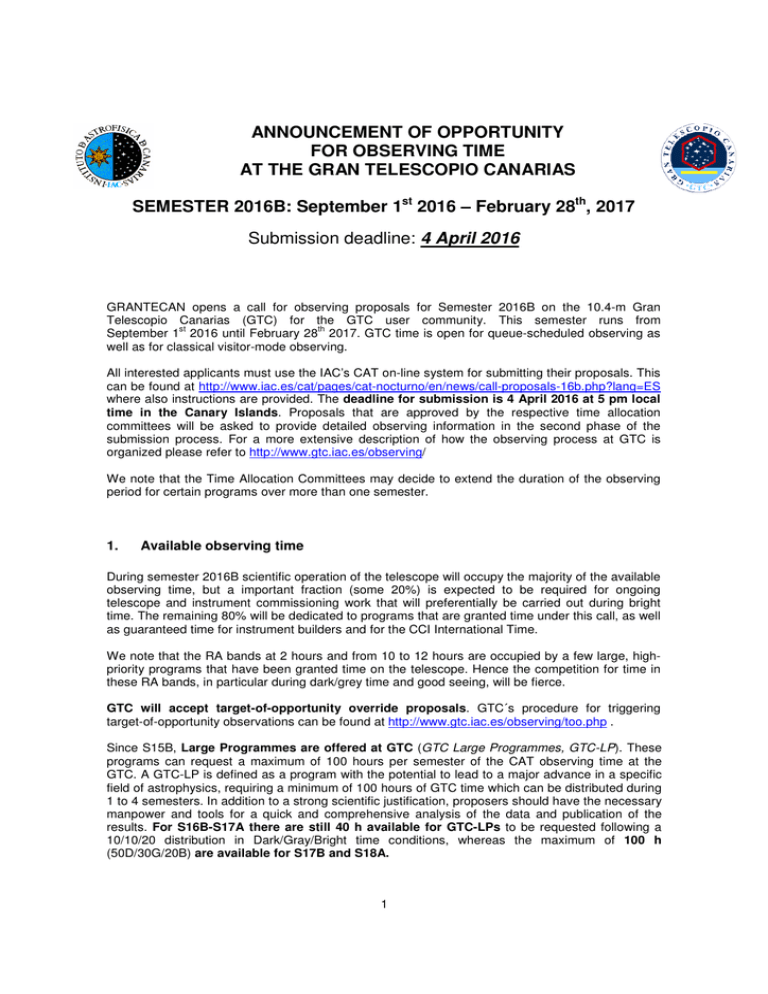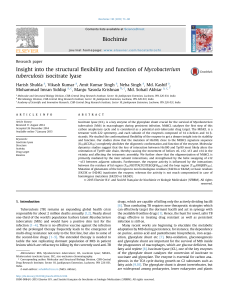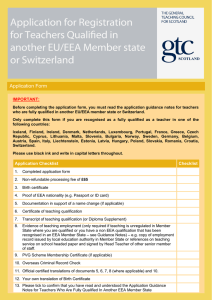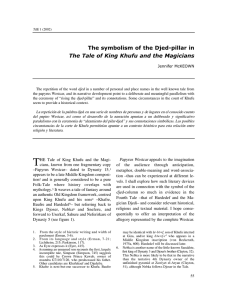ANNOUNCEMENT OF OPPORTUNITY FOR OBSERVING TIME AT
Anuncio

ANNOUNCEMENT OF OPPORTUNITY FOR OBSERVING TIME AT THE GRAN TELESCOPIO CANARIAS SEMESTER 2016B: September 1st 2016 – February 28th, 2017 Submission deadline: 4 April 2016 GRANTECAN opens a call for observing proposals for Semester 2016B on the 10.4-m Gran Telescopio Canarias (GTC) for the GTC user community. This semester runs from st th September 1 2016 until February 28 2017. GTC time is open for queue-scheduled observing as well as for classical visitor-mode observing. All interested applicants must use the IAC’s CAT on-line system for submitting their proposals. This can be found at http://www.iac.es/cat/pages/cat-nocturno/en/news/call-proposals-16b.php?lang=ES where also instructions are provided. The deadline for submission is 4 April 2016 at 5 pm local time in the Canary Islands. Proposals that are approved by the respective time allocation committees will be asked to provide detailed observing information in the second phase of the submission process. For a more extensive description of how the observing process at GTC is organized please refer to http://www.gtc.iac.es/observing/ We note that the Time Allocation Committees may decide to extend the duration of the observing period for certain programs over more than one semester. 1. Available observing time During semester 2016B scientific operation of the telescope will occupy the majority of the available observing time, but a important fraction (some 20%) is expected to be required for ongoing telescope and instrument commissioning work that will preferentially be carried out during bright time. The remaining 80% will be dedicated to programs that are granted time under this call, as well as guaranteed time for instrument builders and for the CCI International Time. We note that the RA bands at 2 hours and from 10 to 12 hours are occupied by a few large, highpriority programs that have been granted time on the telescope. Hence the competition for time in these RA bands, in particular during dark/grey time and good seeing, will be fierce. GTC will accept target-of-opportunity override proposals. GTC´s procedure for triggering target-of-opportunity observations can be found at http://www.gtc.iac.es/observing/too.php . Since S15B, Large Programmes are offered at GTC (GTC Large Programmes, GTC-LP). These programs can request a maximum of 100 hours per semester of the CAT observing time at the GTC. A GTC-LP is defined as a program with the potential to lead to a major advance in a specific field of astrophysics, requiring a minimum of 100 hours of GTC time which can be distributed during 1 to 4 semesters. In addition to a strong scientific justification, proposers should have the necessary manpower and tools for a quick and comprehensive analysis of the data and publication of the results. For S16B-S17A there are still 40 h available for GTC-LPs to be requested following a 10/10/20 distribution in Dark/Gray/Bright time conditions, whereas the maximum of 100 h (50D/30G/20B) are available for S17B and S18A. 1 As this observing time is deduced from the CAT share, only PIs from Spanish institutions can apply for GTC-LPs. There are no rules or restrictions about co-applicants. By the time of this announcement, only OSIRIS can be requested for the execution of a GTC-LP. Full details on this kind of programs, and how to proceed, can be found at: http://www.iac.es/cat/pages/cat-nocturno/en/requesting-time/gtc-large-programmes.php?lang=ES 2. Instrumentation Details of the instruments can be found at http://www.gtc.iac.es/instruments/, including the observing programs for guaranteed time and their reserved targets. OSIRIS: The OSIRIS spectrograph and imager for the optical wavelength range will be available in the Nasmyth-B focal station. Observing modes that will be offered are: - Broad-band imaging Medium-band imaging (SHARDS filters) Long-slit spectroscopy Multi-object spectroscopy Tunable filter imaging using the “red” and “blue” tunable filters Frame transfer and fast photometry mode (only supported in visitor-observing mode) For the MOS mode we highlight the following important constraint: MOS observations will only be carried out for proposals that are highly ranked by the TACs (i.e. in the top half for the Spanish CAT, first and second quartiles). The reason for this is to increase the possibilities to exploit the significant investment in designing and producing the multi-slit masks. Proposals requesting MOS mode that are not sufficiently highly ranked will hence be rejected. For further practical limitations we point the interested reader to http://www.gtc.iac.es/instruments/osiris/osirisMOS.php.Of particular interest for S16B, slit widths as narrow as 0.63 arcsec are now allowed, but users always must be aware of the 0.1 arcsec (r.m.s.) accuracy achievable in the slit positioning when defining the scientific goals of the program. We emphasize the availability of a large medium-band filter set, referred to as the SHARDS filters in reference to the project led by Dr. Pérez González who has offered these filters for general use. Further details, and how to apply for their use, may be found at http://www.gtc.iac.es/instruments/osiris/osiris.php#SHARDS_Filters We remind potential applicants that the standard CCD readout speed is 200 kHz for all observing modes of OSIRIS. CIRCE: CIRCE camera is a visitor instrument provided by the Universidad of Florida (UF) located in one of the Folded-Cass focus at GTC. The current available observing mode it offers include imaging and fast photometry in the near-IR (JHKs bands), in a FOV of 3.4’ x 3.4’ with a 0.1”/pix plate scale. The instrument will be operated without acquisition and guiding unit (as the exposure times in the individual frames will be on the order of few seconds), and it will be externally supported by the UF team (P.I.: Stephen Eikenberry) with minimal participation of GRANTECAN staff. 2 To have access to the fast photometry mode of CIRCE, users must do so through collaboration with the CIRCE science team at the University of Florida (contact person, Stephen Eikenberry [email protected]) which must be arranged before submitting the observing proposal. This mode is only offered in visitor mode, with remote participation of the UF team in the observations, due to its intrinsic complexity. For further details on the instrument’s performance, users must get in contact with University of Florida (contact person, Stephen Eikenberry [email protected]) that will provide the required support. Relevant information can be also retrieved from the instrument web pages at http://www.gtc.iac.es/instruments/circe/circe.php. Finally, users must be aware the all the science publications based on the use of CIRCE will acknowledge both the University of Florida and GRANTECAN, and will include a citation to the CIRCE reference publication: Garner et al. (2014), Proc. of SPIE Vol. 9147, 4 3. Reserved objects The science teams of OSIRIS and CIRCE obtain guaranteed observing time. The objects and observing modes planned for their observations on GTC are reserved for the exclusive use by the instrument science teams. Target lists of reserved objects may be found on the instrument web pages at http://www.gtc.iac.es/instruments/, following the links for OSIRIS and CIRCE. 4. Telescope status The GTC remains under development and various components and functions are already available but other still need to be developed and improved. Of particular interest for potential applicants for observing time we mention that the main dome shutter limitation was solved on November 2015, hence this problem is no longer a limitation for the telescope operation. 5. Observing overheads It is important to make realistic estimates of the observing overheads at the time of writing a proposal, as well as when completing the Phase-2 observing definition. As a guideline, for an OSIRIS observation in both imaging and spectroscopy mode a total overhead of 10 minutes per observing block should be accounted for, while for tunable filter imaging this total overhead increases to about 20 minutes, to account for the TF calibration process. In the case of CIRCE, in addition to the overheads for target acquisition and instrument and telescope setup, which are 10 minutes in the case of imaging, there are also overheads associated to the observing technique. For typical deep exposures, open-shutter efficiency for CIRCE is about 70% (including dithering, readout overheads, etc.). Note that these numbers serve as a guide only and may vary according to the detailed definition of the OB (for example, they don’t include the time for acquisition and throughslit images, if required, as they depend on the exposure time needed). In order to help users to estimate accurately the overheads associated with planned observations there is a Phase 2 simulator available at http://gtc-phase2.gtc.iac.es/science/F2/. We kindly recommend the use of this simulation mode for accounting the total telescope time needed by the time of preparing the present call for proposals. In the case of the use of the OSIRIS tunable filter, for reasons of overall efficiency and since these calibrations are specific for each observing program, we require that applicants define their nighttime calibrations also as observing blocks. The time necessary for these calibrations will be 3 charged to the observing program and should therefore be taken into account in the request for time. See http://www.gtc.iac.es/observing/ for further details. 6. Telescope Support Model Observations can be either carried out in queue-scheduled service mode by trained observatory personnel, or the PIs may express their preference to execute the observations themselves on specific nights according to a set calendar (classical visitor mode). The PI must (i) clearly indicate her/his preference in the proposal form by selecting the appropriate option -“service” or “classical”in the observing mode box of the proposal form, and (ii) in the case of classical observations define a valid backup program that can be carried out if the required observing conditions for the principal program are not met. Visitor programs will only be admitted for those programs that fall in the top half of the TACs ranked list (first and second quartiles). Less highly ranked programs will automatically be placed in the observing queue, with the exception of proposals requesting observing modes that are only admitted in visitor mode (e.g. programs using high-speed readout modes of OSIRIS and/or CIRCE). In classical visitor mode the PI will normally be present at the telescope during the observations, although the interaction with the telescope system will mostly be carried out by trained observatory personnel. The data are immediately made available to the PI. If you would prefer to carry out your observations in visitor mode but cannot be present on the night scheduled for your observations then the GRANTECAN astronomer can carry out the observations for you in service mode. Or alternatively, on the observing night remote contact through eves dropping during the observations is also an option. In this way the PI can remotely assess the data quality and adjust the observing program without the need to be physically present in the control room. To summarize, queue scheduling provides flexibility in optimizing the science return of the telescope depending on the atmospheric and technical circumstances each night. Priority is given to the scientifically most highly ranked proposal that is suitable for the observing conditions. In general, proposals with relaxed observing constraints will have a better chance of being completed successfully. In classically scheduled observations, on the other hand, dates of observation are fixed and the risk of poor weather conditions and technical failures rests with the PI, but it provides the advantage of the PI being able to adapt the observing plan in real time. GRANTECAN will aim to follow the preference of the PI when drawing up the observing schedule, but no guarantee can be given that all preferences can and will be honored. In particular in case a proposal conflicts with high-priority programs, or in case of a low ranking by the TAC, the proposal will most likely not be scheduled in classical visitor mode. For all observations, after the one-year proprietary period the raw data is copied to the GTC Public Science Archive, hosted at the Center for Astrobiology in Madrid (http://gtc.sdc.cab.inta-csic.es/gtc). PIs are also encouraged to contact archive staff at CAB to submit their reduced data once they have been published. For general queries, contact Antonio Cabrera Lavers: [email protected] 4




